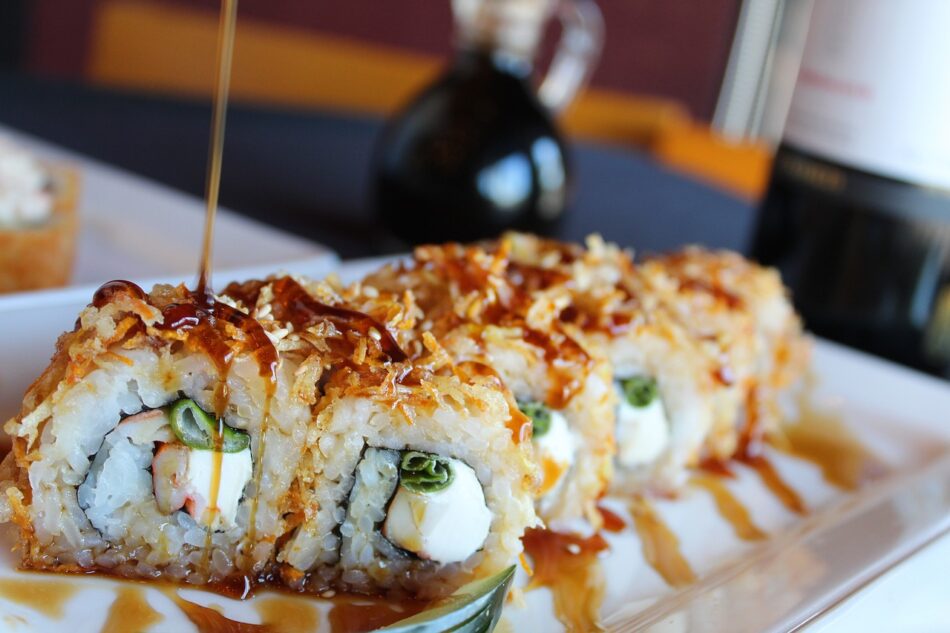Making sushi rice at home may seem intimidating, but it’s actually quite simple when you know the steps. The key to perfect sushi rice lies in the right ratio of ingredients and the proper cooking and seasoning technique. By following these steps, you can make sushi rice that is flavorful and sticky, just like the one served in your favorite sushi restaurant.
First, you need to rinse the short-grain rice thoroughly in water to remove excess starch and impurities. Then, cook the rice in either a rice cooker or a stovetop pot using the correct water-to-rice ratio. While the rice is cooking, prepare the seasoning by boiling a mixture of rice vinegar, sugar, and salt in a small saucepan. Once the rice has finished cooking, transfer it to a large bowl and mix it gently with the seasoning mixture using a wooden spoon or spatula. Finally, allow the rice to cool down to room temperature before using it for sushi rolls to avoid altering its texture.
By mastering these simple steps, you will have a delicious base for any sushi roll that you can customize with your favorite ingredients. Don’t be afraid to experiment and have fun with your sushi rice!
Ingredients
Before we dive into the step-by-step process of making sushi rice, let’s talk about the essential ingredients needed. First and foremost, you will need short-grain rice. It’s important to use this type of rice as it has a higher starch content which makes it sticky and perfect for sushi rolls.
Next, you will need rice vinegar, sugar, and salt. These three ingredients make up the seasoning that is added to the cooked rice. The ratio of these ingredients is crucial to achieving perfect sushi rice. A common ratio is 1/4 cup rice vinegar, 1 tablespoon sugar, and 1 teaspoon salt for every 2 cups of cooked rice.
It’s important to note that you should use high-quality ingredients to ensure the best flavor in your sushi rice. With these essential ingredients in mind, let’s move on to the step-by-step process of making sushi rice.
Step 1: Rinse the Rice
In order to make flavorful and perfect sushi rice, it is important to rinse the rice thoroughly before cooking. This step removes excess starch and any impurities that may be present in the rice.
To properly rinse your rice, add it to a large bowl and cover it with cool water. Use your hands to gently stir the rice around, allowing the water to loosen any dirt or debris. Drain the water and repeat this process until the water runs clear.
It is important to note that rinsing the rice can impact the final texture and stickiness of the rice. If you prefer a stickier rice, rinse it quickly and lightly. If you prefer a less sticky rice, rinse it thoroughly and more vigorously.
After rinsing the rice, it is ready to be cooked according to the package directions or with your preferred cooking method.
Step 2: Cook the Rice
In order to make delicious sushi rice, it is important to cook it correctly. You can either use a rice cooker or a stovetop pot to cook the rice. Make sure to follow the package directions and use the correct water-to-rice ratio. Short-grain rice is recommended for making sushi rice as it has a higher starch content, which makes it more sticky.
If you are using a rice cooker, simply add the rinsed rice to the cooker and add water according to the instructions. Once the rice is cooked, let it sit for a few minutes before opening the lid. Fluff the rice with a fork and transfer it to a large bowl.
If you are using a stovetop pot, bring the rice and water to a boil in a pot, reduce the heat to low, cover, and simmer for about 18-20 minutes. Once the rice is cooked, remove it from the heat and let it sit for a few minutes with the lid on before fluffing it with a fork and transferring it to a large bowl.
Remember to be careful when handling the hot pots and always follow the package instructions for cooking the rice. A perfect sushi roll starts with perfectly cooked rice!
Step 3: Prepare the Seasoning
To prepare the seasoning for your sushi rice, you will need a small saucepan, rice vinegar, sugar, and salt. In the saucepan, combine the rice vinegar, sugar, and salt, and bring to a gentle boil over medium heat. Stir the mixture regularly until the sugar and salt dissolve completely. Once the seasoning has reached a gentle boil and the sugar and salt have dissolved, remove it from the heat and set aside to cool.
The seasoning is essential in bringing out the perfect flavor and balance in your sushi rice. Ensure that the sugar and salt are completely dissolved before adding the mixture to your rice. Once cooled, slowly add the seasoning to the cooked rice while gently mixing it with a wooden spoon or spatula. This ensures that the seasoning is evenly distributed throughout the rice.
Note that the sushi rice should be at room temperature when adding the seasoning. Try to avoid placing it in the fridge as this will alter the texture of the rice. With these steps and tips, you can make delicious sushi rice that will add flavor and balance to your sushi rolls.
Step 4: Mix the Rice and Seasoning
To make the perfect sushi rice, the seasoning mixture must be mixed thoroughly with the cooked rice. Once the rice has finished cooking, transfer it to a large bowl and slowly add the seasoning mixture. It is important to mix the rice gently with a wooden spoon or spatula to prevent it from becoming too mushy and ruining the texture.
To achieve the perfect balance of flavors, the amount of seasoning added to the rice should be carefully measured. It is recommended to start with a smaller amount of seasoning and adjust to taste, adding more if necessary.
Using a rice paddle to mix the rice and seasoning is also recommended as it allows for even mixing and prevents the rice from breaking apart.
After the seasoning and rice have been thoroughly mixed, it is important to let the rice cool down to room temperature before using it for sushi rolls. At this point, the rice should be slightly sticky and have a subtle, yet delicious, flavor.
Step 5: Cool the Rice
Step 5 is a crucial step in making sure your sushi rice is of the highest quality. Once the rice and seasoning are well combined, you need to let the rice cool down to room temperature before using it for sushi rolls. Cooling the rice allows it to become more sticky and easier to form into rolls.
It is important to note that you should avoid placing the rice in the refrigerator as it will alter the texture and consistency of the rice. Instead, spread the rice out on a flat surface and use a fan to help cool it down. This will ensure that the rice is at the perfect temperature when it’s time to start making your sushi rolls.
If you’re in a hurry, you can speed up the cooling process by using a wooden fan or a hand-held fan to cool the rice more quickly. Just be careful not to cool the rice too much as it will become dry and difficult to work with.
Final thoughts
Making sushi rice at home may seem like a daunting task, but by following the steps outlined above, anyone can make delicious sushi rice that is ready for any sushi dish. The key to perfect sushi rice is patience and attention to detail. By taking the time to thoroughly rinse the rice, cook it properly, and mix in the seasoning mixture gently, you will be rewarded with delicious, sticky rice that is the perfect complement to any sushi roll.
It’s important to remember that allowing the rice to cool down to room temperature is crucial to achieving the optimal texture. Placing the rice in the refrigerator can cause it to become hard and lose its flavor.
So, what are you waiting for? Start making your own sushi rice today and enjoy the satisfaction of creating a delicious and authentic sushi experience at home.








